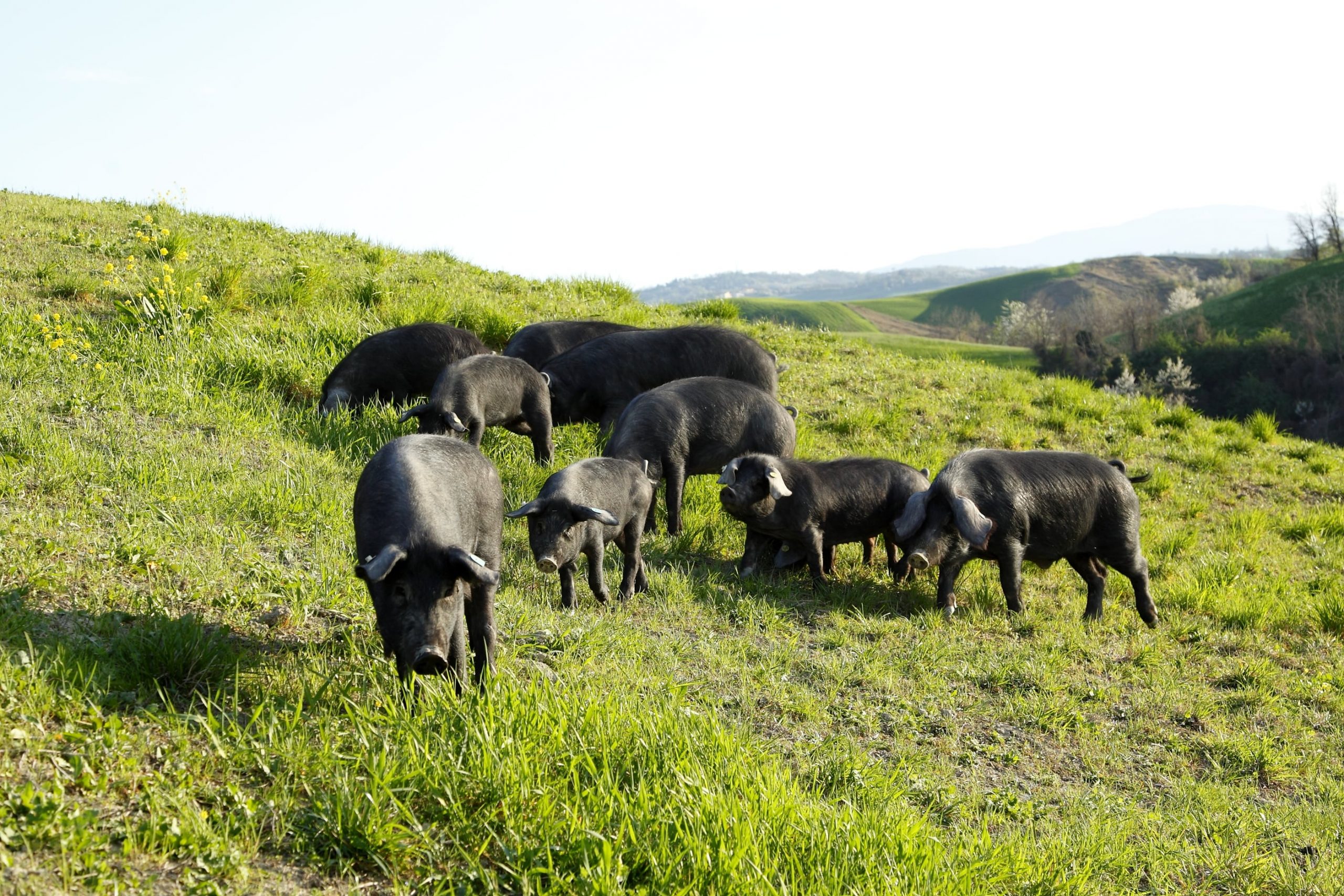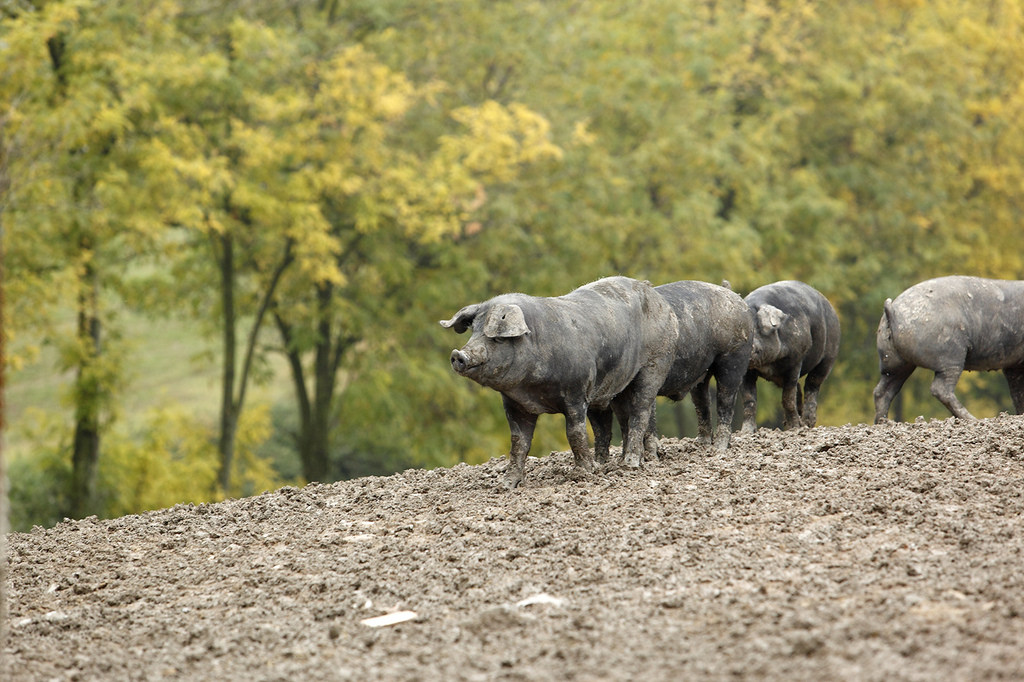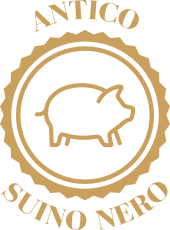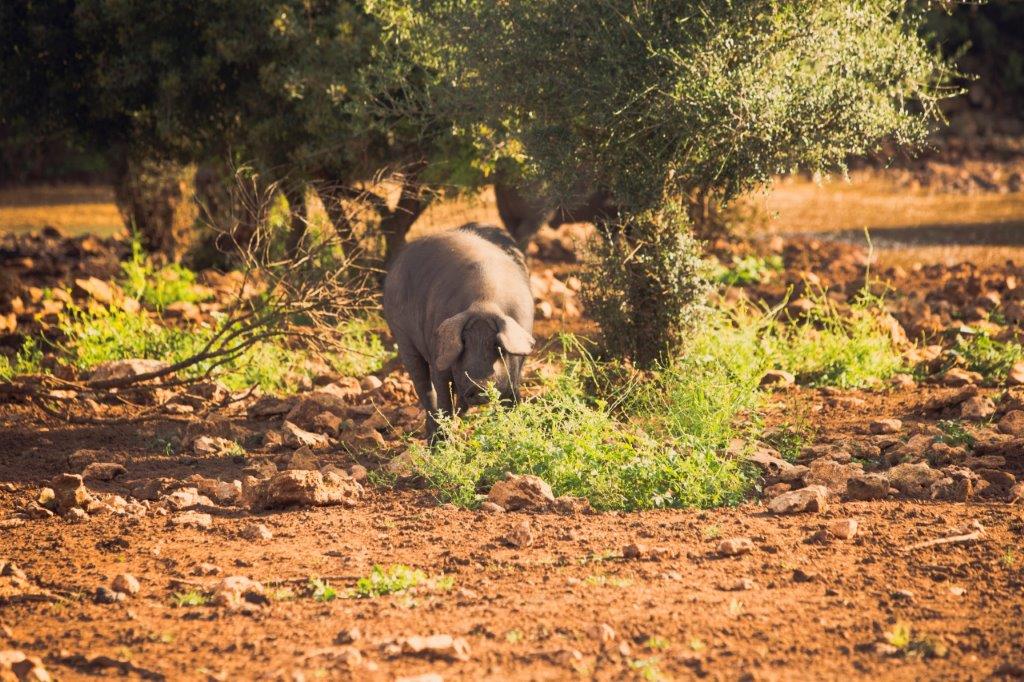
THE WINNERS
The Italian and European Suino Nero
The history of the pig is closely intertwined with that of mankind starting from a particular historical moment: the so-called ‘Neolithic Revolution’. During this time, we witness the transition from nomadic groups whose nourishment came mainly from hunting and gathering seeds and spontaneous fruits, to the establishment of a sedentary lifestyle.
THE WINNERS
The Italian and European Suino Nero
The history of the pig is closely intertwined with that of mankind starting from a particular historical moment: the so-called ‘Neolithic Revolution’. During this time, we witness the transition from nomadic groups whose nourishment came mainly from hunting and gathering seeds and spontaneous fruits, to the establishment of a sedentary lifestyle.
By settling down, humans dedicate themselves to more solid ways of obtaining food. Thus, agriculture and animal farming are born. The domestication of the pig, however, has an uncertain date. According to some historians, the first archaeological traces are to be placed between 4500 and 5000 BCE in South Asia while, according to others, they are to be found in the Middle East and the eastern coasts of the Mediterranean, between Palestine, Iraq, Turkey and Greece. On the slopes of the Taurus Mountains, in south-eastern Turkey, thanks to discoveries made in 1964, there is evidence of how pig farming predates the cultivation of cereals such as wheat and barley, and dates back to about 8000 BCE.
Although the diffusion of the first farmers and breeders sees Mesopotamia as the first fertile place suitable for the stabilization of man, over the years there is a diversification between sheep and goat farming in the middle-eastern area of Europe. The area that sees a greater diffusion of the pig is the central-northern one, thanks to the presence of woods from which to draw nourishment. Originally the pig had different physical characteristics than today. In fact, it was slenderer, had more tapered legs and a dark or reddish color, with bristly hair along the back. The weight was different as well: it reached between 70 and 80 kg when it was 2 or 3 years old.
Until the 1800s pork meat was preferred over other species for its particular fatness and richness nutrition which, therefore, did not require the addition of spices or other seasonings and proved to be more suitable for processing. From the 18th century there was a progressive increase in pig breeding until it became exhaustive, which encouraged a greater selection of animals. The first true breed of domestic pig came when this type of selection focused on less aggressive and larger animals, aimed at obtaining a larger amount of meat. Therefore, the selection of the species Large White or Yorkshire, from the homonymous place in England, dates back to 1805.
However, it was in 1860, after years of selection and crossbreeding between pigs of Chinese and Siamese origins, with the setting of distinguishing characteristics such as fertility, large size and small skeleton, which guaranteed a greater yield in the slaughtering phase that the official recognition of the Large White breed occurred. As it happened with other animal species, pigs have also experienced a reduction in the number of Italian breeds in favor of the more productive foreign ones. In Italy, the same Large White, imported by Antonio Zanelli in 1873, in the Improved Animal Deposit annexed to the Agricultural Technical Institute of Reggio Emilia, spread rapidly both in the Po Valley and in other parts of the country thanks to its ability to pass on its qualities to the offspring. Widespread and preferred in Italy from the twentieth century onwards, as a crossbreed, it almost entirely replaced the native pigs. However, the introduction of foreign breeds did not end with the Large White. In fact, it was followed by the Middle White, Large Black and Tamworth breeds, which were used several times also as crossbreeds. As for our ancient black pigs, 7 officially recognized breeds survive today in Italy.

The Nero Siciliano, raised mainly in the province of Messina, particularly in the Monti Nebrodi, for which it is often known as the Nero dei Nebrodi, with a resemblance to the wild boar, today constitutes a small representation of two thousand heads. Equally exiguous are the artisans who know how to process the meat and who prefer the butchering and processing for family use. However, the resulting products are excellent, thanks to the intense aroma of its meat and their predisposition to long aging. The Fellata Salami, the Nebrodi sausage, the capocollo, pancetta, lard or the guanciale, also locally called ‘boccularu’, are among the most exceptional products.
Typical of Campania and of very ancient origin, the Nero Casertano is represented in many sculptures and frescoes already dating back to Roman times. It is certainly the most precocious and productive breed among the Italian breeds and it is identified by its dark and hairless skin, from which the name Pelatella (bald) comes from, and it owes its fame and appreciation to the particular marbling of its meat. Deriving from its Iberian cousin, with its equally lean meat and renowned for its excellent quality, it stands out for the typical flavor due to the concentration of intramuscular connective tissue and the amazing tenderness. The Casertano breed lends itself to cured meats such as sausages, capocollos, pancetta and soppressata.
The Nero di Calabria, or Apulo-Calabrese, with its lean meat typical of a diet based on acorns, tubers and roots, adapts very well to breeding in a wild or semi-wild state and, unlike improved breeds, its growth is slow. The soppressata, the sanguinaccio (blood sausage), the ’Nduja of Spilinga, the capocollo and the lard are the exquisite cured meats obtained from this pig which has a kinship with the Nero Casertano and with specimens of Apulian origin as well.

Protected by the PDO status, the Cinta Senese takes its name from the characteristic white ‘Cinta’ (belt or band) that surrounds the trunk at shoulder level including the forelimbs and from the area of origin, the Montagnola Senese. It is among the most ancient Italian swine breeds. In fact, we can find traces of it already in Roman, Etruscan and Medieval times. One of the main characteristics of this species is its rusticity which makes this pig an excellent grazer, suitable for the most inaccessible environments and it is able to use the food resources available in the area of the Mediterranean scrubland. Its meat, with a redder and darker color than other breeds, is well suited to absorb and distribute the aromas used to flavor it, thus providing salamis and products with typical and pleasant aromatic notes such as Tuscan prosciutto, salted shoulder, porchetta, sausages, guanciale, lard, capocollo and finocchiona (characterized by the use of fennel).
The Mora Romagnola is a historical breed which owes its name to its dark color, dark brown tending towards black, and its region of origin, Emilia Romagna. The breed features a soft and juicy meat, lipidic, marbled and with a more intense color than other species. Although originally there were three variants, the Forlivese from the area of Forlì, the Faentina from the Faenza area, and the Riminese from the Rimini area, today this breed is widespread also in many areas of northern Italy. During the 1990s, the pure breed was very close to extinction, reduced to very few specimens concentrated in few breeding farms, and only the activation of the registry in 2001 allowed to set up the basis for a gradual and progressive recovery. It is a medium-sized breed, with a thin but solid skeleton and a thicker ridge of longer and hard bristles running along the spine which form a kind of mane called the ‘Sparta line’, a peculiar characteristic of the breed. The Mora Romagnola is a slow-growth pig breed. The typical sweetness of its meat makes it perfect for the production of soft cured meats such as high-quality salami as well as cotechino, culatello and cured shoulders.
From a historical point of view, pig breeding in Parma is a deeply rooted activity that has been documented as early as the end of the 15th century. At that time, black-coated pigs, which reached considerable weights, were particularly appreciated. The particular ruby red color defines a native pig species with lipidic meat, with large marbling: the Nero di Parma. Derived from a recently implemented selection process, it resembles the ancient Nera Parmigiana or Reggiana breed, of which the Parma area has made it a standard of the pork-butchering tradition. This area is accustomed to and known for its charcuterie and derives from the indigenous species cured meats such as culatello, salami, prosciutto, coppa and pancetta thanks to its appreciable adipose quality.
A ’new’ swine breed recognized by MIPAFF (Italian Ministry of Agricultural, Food and Forestry Policies) in February 2020, the Nero of Cavour, Nero of Piemonte or Nero Piemontese, is a hardy breed that is well suited to breeding in a wild or semi-wild state. The typicality of this type of food lends itself to the production of Piedmontese cured meats, such as prosciutto and ham, sausages and capocollo thanks to the particularly consistent texture and the good marbling that the meat presents. The main characteristics of this new established breed are the black coat and slate-grey color skin, a white face with white stockings on the lower part of the limbs.

As for pig breeding in the rest of Europe and the production of cured meats and cured salami, Portugal, Spain, the Balearic Islands (Majorca), France, Germany and Hungary stand out. Specifically, in Portugal two breeds are more common: the Porco Bìsaro in the north, from the Tagus River to the border with Galicia, and the Porco Alentejano in the south. The Bísaro pig has two varieties: one with white spots, common in the Minho area, and one with black to gray or black spots, found in the Minho, Trás-os-Montes and Beiras regions. Much appreciated in Portugal, with many culinary uses, its meat is eaten fresh – on the spit or ‘cozido à portuguesa’ – or in the production of a wide variety of traditional dishes – including PDO and PGI – such as chouriços, salpicões, ham and other traditional products. The Porco Alentejano PDO is also a breed from which traditional Portuguese gastronomic products are obtained, precisely because of its fine-grained meat which is very tasty and succulent.
In Spain, the most common pig is the Iberian pig, from which the Iberian Jamón de Bellota (aged back leg of the pig), as well as the Paleta (aged shoulder of the pig), the Lomo (dry-cured pork loin), Chorizos and Salchichones (salami and sausages) are produced and which make Spain one of the countries in Europe with the highest consumption of cured meats. The Iberic Jamón stand out above all in the four different PDO types: Jamón de Huelva, Valle de Los Pedroche, Dehesa de Extremadura and Jamón de Guijuelo. The most commonly used breeds are the ‘Negro Entrepelado’ and the ‘Negro Lampiño’, respectively with and without fur. The Iberian pigs, thanks to a diet based on acorns and fresh pasture grass, typical of a very unique environment, the dehesas (wild pastures of the peninsula) give back pork-butchery jewels that feature an unmistakable, intense and long-lasting aroma.
The Cerdo Negro Mallorquín, a breed native to Majorca, is the result of a cross between the Iberian and Celtic breeds. Its lipidic and aromatic meat is used to produce Sobrasada de Mallorca, a typical and characteristic cured sausage from the Balearic Islands, which has had PGI status since 1996. Similar to the Iberian pig is also the Noir de Bigorre, which originates in the foothills of the French Pyrenees and is raised in an area around the French town which bears the same name.
The Jambon Noir de Bigorre PDO is produced from the Noir de Bigorre pig, the oldest breed of pig known in France which is finely veined with fat, followed by the Basque pig from the Aldudes Valley, also known as the Basque Country Pie Noir pig, typical of the town of Quinta, from which the Jambon du Kintoa PDO is produced. Equally of historical origins is the Porc de Corse PDO, typical of Corsica. Bred for centuries in the semi-wild state, the cured meats produced from this indigenous black pig are the Prosciutto PDO, the Coppa de Corse (salted and aged back meat) and the Lonzu (salted and aged loin).
In Germany, where native species are almost completely extinct, the pork-butchery tradition is based on the meat of the above mentioned white pigs, from which high-quality cured meats are produced such as the Schwarzwälder Schinken PGI, also called Black Forest Ham.
Hungary and the Balkans, on the other hand, have a native and historical breed, the Mangalica. One of the distinguishing features of this breed is its fat. In Hungarian, in fact, Mangalica means ‘pork with a lot of fat’. Large in size and with a long, thick and curly coat, it differs from other species because it resembles a sheep. Colloquially, in fact, it is known as the ‘pig-sheep’. Despite being in vogue today, the Mangalica has been on the verge of extinction. In 1991 the number of specimens was very low and the breed was facing an almost total extinction. However, following an enormous request from Spain by the company Jamones Segovia SA, the breed regained strength. There are currently three existing varieties of Mangalica, differing only by the color of their coat: white, blonde and swallow-bellied (a blonde belly and feet with a black body). The ‘red’ Mangalica pigs are ginger-colored and are very valuable and refined, as they produce meat with a large marbling, guaranteed by the semi-wild breeding and the nutrition based on wheat, barley, corn, mineral supplements and green fodder. Compared to its Spanish counterpart, the fat of the Hungarian pig is even silkier. In fact, Mangalica pigs produce a meat so delicious it’s been hailed as the “Kobe beef of pork”.
Learn more about the project

If we were to trace the parting moment in the history of organic farming, this would be the turn of the millennium.

Cutting is one of the oldest workers association associated to the art of cured meats.

This section collects haute cured meat products that are little known due to their small production but which are worth looking for.

To defend the typicality of certain food products, the EU has established two levels of denomination: PDO and PGI.

Our research work also analyzes the best locations in Italy where to taste selected and sought-after cured meats, proposed and spoken about with passion.
